 It is a hot, summer’s day – you are in your car, traffic has come to a halt and your patience is at its end. Ahead you can see the hustle and bustle of the heavy equipment repairing the nation’s highways and byways – never ending. Among these specialized machines is the subject of this article; the Paver – or Asphalt Finisher. A machine whose purpose is to receive a dump truck loads of a hot, sticky, black, petroleum based product into one side of the machine and distribute it evenly out the other side in order to create the roadways for our Sunday drives. In this article I will show some of the products and techniques that can be used to create the severe staining and discoloration caused by the extreme conditions found on road construction sites. Specifically the paving machine, whose constant contact with asphalt, grease and grime make it the perfect choice for weathering.
It is a hot, summer’s day – you are in your car, traffic has come to a halt and your patience is at its end. Ahead you can see the hustle and bustle of the heavy equipment repairing the nation’s highways and byways – never ending. Among these specialized machines is the subject of this article; the Paver – or Asphalt Finisher. A machine whose purpose is to receive a dump truck loads of a hot, sticky, black, petroleum based product into one side of the machine and distribute it evenly out the other side in order to create the roadways for our Sunday drives. In this article I will show some of the products and techniques that can be used to create the severe staining and discoloration caused by the extreme conditions found on road construction sites. Specifically the paving machine, whose constant contact with asphalt, grease and grime make it the perfect choice for weathering.
Die Cast models can be a good choice when looking for unique subjects to model. When the model is new the glossy paint finish the model looks more like a child’s toy. This article is excerpted from Issue 4 of The Weathering Magazine, the Engines, Oil and Grease Issue. The Asphalt Machine being one of two contributions to the magazine – the other being the engine treatment on the Diamond Reo Truck. The format in the magazine is based upon photo captions, and thus, the text below are simply the photo captions, rather than complete paragraphs.
-
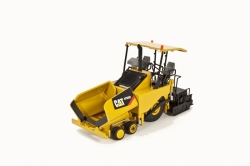
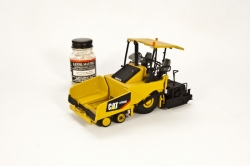
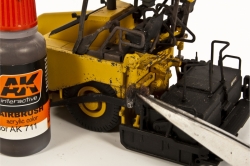
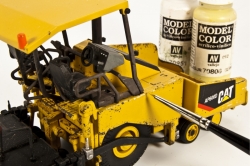
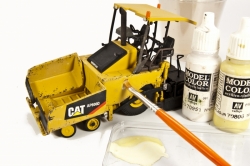
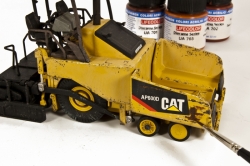
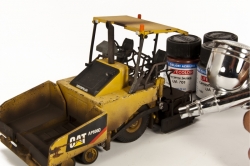
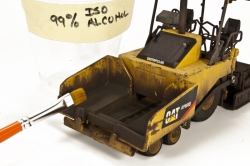
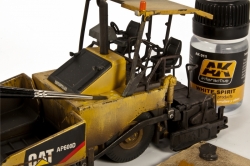
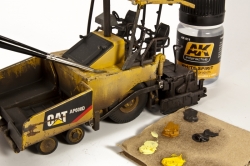
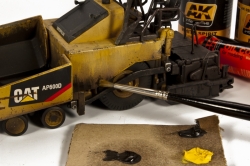
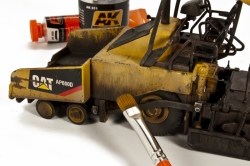
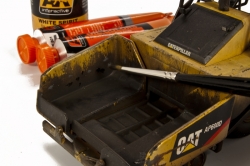
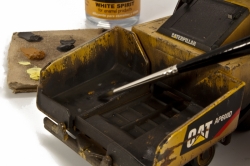
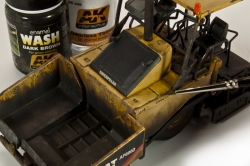
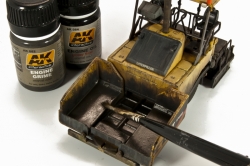
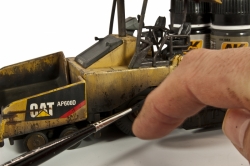
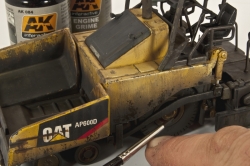
It is difficult to paint directly onto the high gloss finish of the newly purchased die cast model. The first step is to give the surface a bit of “tooth” or texture by applying a light misting of a matte finish.
- A scrubbing pad and a small amount of paint can be used to apply chips and scratches to the vehicle surfaces. Photo 8f: Surface chips and paint scuffs simulated using a pale yellow color applied with a fine tip brush.
- Varying mixes of rust and grey paints are used to create a grimy, dirty color which is airbrushed onto the lower body and front bucket to form the basis for the heavier weathering that follows.
- Looking at real world vehicles I can see that the tar and asphalt stains are not uniformed, but rather occur in streaks. To create this appearance I use a soft, wide brush dampened with 99 % Isopropyl Alcohol to gently remove the base grimy base color – downward strokes are used. One must be very careful when doing this procedure as the alcohol is very aggressive toward the paint finish. A second brush loaded with tap water is useful to control or stop the stripping process.
- These initial foundation layers of paint and weathering are protected from the subsequent weathering processes by a light layer of AK Interactive Satin Varnish.
- Chromatic richness and paint fading is achieved by the use of pale yellow and cream colored artists oils carefully worked into the surface finish. Photo 20f: Heavy stains of tar and grease are created on the lower body by heavy applications dark colored of artist’s oils.
- Again using a wide brush dampened with white spirits the heavy applications of artist’s oils are blended into the finish – downward strokes reinforce the streaking effect. Photo 22f: The front bucket receives the same type of artist’s oil treatment as on the vehicle sides. Notice that grey colors are also used in order to enhance the depth and visual interest of the dark colors.
- Thinner is first applied along panel lines and surface details in order to break surface tension. This is followed by a light application of Dark Brown Wash along panel lines and surface details in order enhance definition.
- A liberal mix of AK Engine Grime and AK Engine Oil are spread into the interior of the bucket. I can use the different sheen’s of the two effects; the glossy nature of the Engine Oil and the Matte finish of the Engine Grime, to replicate older stains and more recent stains.
- A brush loaded with AK Engine Grime and AK Engine Oil is flicked by my finger to produce random splashes and drips along the lower areas of the vehicle.
|




I want that paver